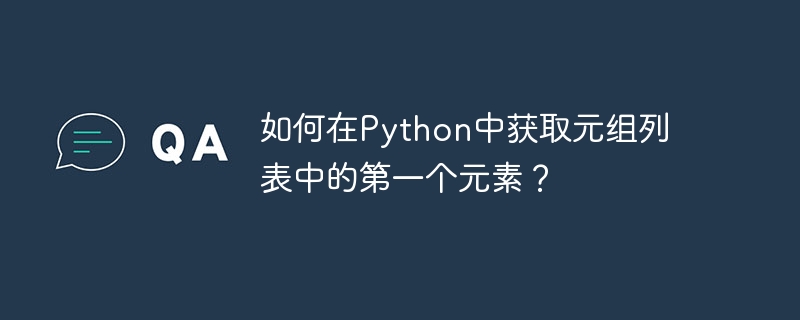如何在Python中获取元组列表中的第一个元素?
- 王林转载
- 2023-09-08 16:45:022649浏览

元组是 Python 中不可变的数据类型,可以保存异构数据类型。另一方面,列表是可以容纳异构数据的多种数据类型。在本文中,我们将探索使用基于函数的组件从元组列表中检索第一个元素的各种方法。我们将探索几种方法,如循环、列表理解、zip 方法等。
使用循环方法
循环是几乎所有编程语言中的常见语句。我们可以使用循环语句以及Python可迭代对象的索引属性来访问可迭代对象的第一个元素。由于在我们的例子中,我们只想访问第一个元素,因此我们可以在每次迭代中使用索引号 0。
示例
在下面的示例中,我们创建了一个函数,该函数返回一个列表作为输入,并以列表数据类型的形式返回列表的所有第一个元素。在该函数下,我们创建了一个空元组,并且在列表的每次迭代下,我们将元组元素的第一个元素附加到初始化的列表中。后来我们创建了一个元组并调用该函数来测试结果。
def get_first_element_using_loop(tuples_list):
first_elements = []
for tuple in tuples_list:
first_element = tuple[0]
first_elements.append(first_element)
return first_elements
t = [
('Apple', 5, True),
('Banana', 3, False),
('Orange', 2, True),
('Grape', 4, False),
('Mango', 6, True)
]
print(f"The first elements of the list are: {get_first_element_using_loop(t)}")
输出
The first elements of the list are: ['Apple', 'Banana', 'Orange', 'Grape', 'Mango']
使用列表理解
列表推导式是在 Python 中组合表达式和语句并使用它们在列表中创建元素的一种非常方便的方法。根据我们的需要,我们可以使用索引方法和for循环作为条件表达式来创建列表中的元素。
示例
在下面的示例中,我们创建了一个函数,它接受列表并返回包含元组的所有第一个元素的列表。我们使用列表理解技术来创建名为first_elements 的列表元素。
def get_first_element_using_comprehension(tuples_list):
first_elements = [tuple[0] for tuple in tuples_list]
return first_elements
t = [
('Apple', 5, True),
('Banana', 3, False),
('Orange', 2, True),
('Grape', 4, False),
('Mango', 6, True)
]
print(f"The first elements of the list are: {get_first_element_using_comprehension(t)}")
输出
The first elements of the list are: ['Apple', 'Banana', 'Orange', 'Grape', 'Mango']
使用Map方法
Map 是 Python 的另一个重要的内置方法。 map 方法将函数应用于可迭代对象的所有元素。它有两个参数,即函数名称和可迭代对象。我们可以使用 lambda 函数和 map 方法来访问列表中元组的第一个元素。
示例
在下面的示例中,我们创建了一个名为 get_first_element_using_map 的函数,该函数获取由元组元素组成的列表,并返回该列表的元组元素的所有第一个元素。我们使用 map 方法将 lambda 函数应用于每个列表元素。
def get_first_element_using_map(tuples_list):
first_elements = list(map(lambda x: x[0], tuples_list))
return first_elements
t = [
('Lemon', 3, False),
('Strawberry', 7, True),
('Watermelon', 1, True),
('Pineapple', 4, False),
('Kiwi', 2, True)
]
print(f"The first elements of the list are: {get_first_element_using_map(t)}")
输出
The first elements of the list are: ['Lemon', 'Strawberry', 'Watermelon', 'Pineapple', 'Kiwi']
使用解包技术
这是提取所有第一个元素的棘手方法。首先,我们可以使用for循环;接下来,我们可以通过指定一些名称来解压第一个。我们还可以用*指定其他元素。我们可以使用列表理解将所有元素附加到列表中。
语法
for first_element, *_ in iterable:
# other codes
这里我们将第一个元素指定为first_element。请注意,您可以为其指定任何名称。接下来,“*_”指定我们还有其他元素,但我们对这些不感兴趣。 “可迭代”是任何可迭代对象,例如元组列表等。
示例
在下面的代码中,我们使用了Python的列表理解技术和解包技术。这里我们将列表中每个元组元素的第一个元素命名为first_element,并将其附加到列表中。我们创建的函数是一个非空函数,它返回生成的列表。
def get_first_element_using_unpacking(tuples_list):
first_elements = [first_element for first_element, *_ in tuples_list]
return first_elements
t = [
('Lemon', 3, False),
('Strawberry', 7, True),
('Watermelon', 1, True),
('Pineapple', 4, False),
('Kiwi', 2, True)
]
print(f"The first elements of the list are: {get_first_element_using_unpacking(t)}")
输出
The first elements of the list are: ['Lemon', 'Strawberry', 'Watermelon', 'Pineapple', 'Kiwi']
使用Zip方法
Python 中的 zip() 函数是一个内置函数,允许您将多个可迭代对象(例如列表、元组或字符串)组合成单个元组迭代器。 zip() 生成的每个元组都包含输入可迭代中相应位置的元素以及元素本身。由于返回值是由元组元素组成的列表,因此我们可以使用索引方法来访问列表的第一个元素。
示例
在下面的代码中,我们创建了一个非空函数,它将列表作为参数并返回元组列表中的第一个元素。如果打印 list(zip(*tuples_list)) 的结果,您将得到如下结果:
[('柠檬', '草莓', '西瓜', '菠萝', '猕猴桃'), (3, 7, 1, 4, 2), (False, True, True, False, True)]
由于我们只想要列表中的第一个元素,因此我们使用索引方法并设置index=0。
def get_first_element_using_unpacking(tuples_list):
return list(zip(*tuples_list))[0]
t = [
('Lemon', 3, False),
('Strawberry', 7, True),
('Watermelon', 1, True),
('Pineapple', 4, False),
('Kiwi', 2, True)
]
print(f"The first elements of the list are: {get_first_element_using_unpacking(t)}")
输出
The first elements of the list are: ('Lemon', 'Strawberry', 'Watermelon', 'Pineapple', 'Kiwi')
结论
在本文中,我们了解了如何在 Python 中获取元组列表中的第一个元素。 Python 中有多种方法可以用来执行任务,例如循环方法、列表理解、解包等。哪种方法最好的答案取决于使用情况和其他因素。我们强烈建议读者尝试这些概念,以更好地理解这些主题。
以上是如何在Python中获取元组列表中的第一个元素?的详细内容。更多信息请关注PHP中文网其他相关文章!

